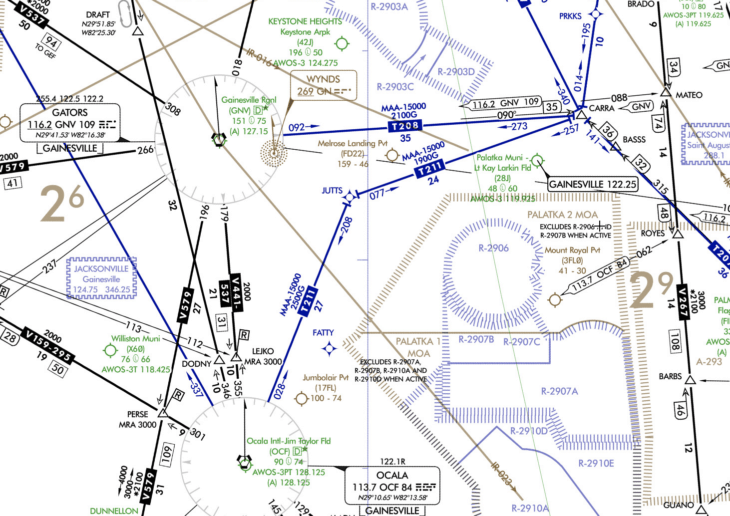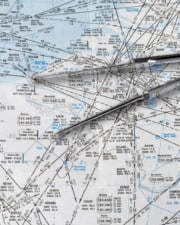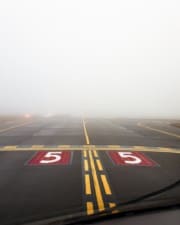Modern small aircraft pilots can be forgiven for taking the “direct to” button on their GPS for granted. The ability to navigate straight to any point on the planet is a powerful tool in the cockpit. GPS has brought this technology to nearly every plane in the sky, but the concept has been around for many decades.
Table of Contents
RNAV stands for “area navigation” in aviation. Area navigation is the ability to navigate directly between any two points on earth. The most common type of RNAV equipment today is GPS, but several older technologies have been in use on larger aircraft for decades.
The Beauty of “Direct To”
VFR pilots have always been able to go directly to their destination. They may have to make a few miles diversion for airspace or obstacles, but they can generally use any points they desire along the way. Being able to use physical landmarks they can see is a big help.
If you remove the use of visual landmarks, instrument pilots are entirely reliant on electronic navigation sources. This has meant flying directly to or directly away from a VOR or NDB radio station on the ground. The resultant path is seldom a straight line between the departure point and the destination.
VOR/DME RNAV
Before GPS came along, two other RNAV systems enjoyed popularity. Avionics manufacturers created systems that would use existing VORs and DMEs to create phantom waypoints. For example, the pilot could program a waypoint 20 miles south of the ABC VOR by programming it as ABC180020.0 (VOR-radial-distance). The aircraft could then be flown directly to this point as if that’s where the ABC VOR was located.
While those early VOR/DME RNAV systems are few and far between these days, the location coding of phantom waypoints is still used throughout aviation. When a specific location is written down, for example, to depict a flight restriction or obstacle, the VOR-radial-distance is often given. This is easy to decipher on any aeronautical chart.
Inertial Navigation
More advanced aircraft could carry more sophisticated and expensive avionics systems. One of the coolest RNAV systems around is INS (inertial navigation system). These systems contain gyros that sense aircraft movement, so navigation is wholly based on measurements taken inside of the aircraft. No ground radio stations are necessary after the system gets an initial fix. Many large airplanes contain two units so that they can compare their results and compensate for any errors.
INS, and their newer cousins IRS (inertial reference systems), are incredibly accurate, with errors of only 0.4 NM after four to six hours of flying. So, for example, a trans-Atlantic flight could depart from an airport and cross the ocean with only a 0.4 NM error, all with no outside help! To add to system redundancy and to further increase their accuracy, INS/IRS units typically also receive VOR or DME signals. When combined with ground-based navigation systems like DME, these systems can maintain their position fixing indefinitely.
These units have been used for decades on airliners and business jets. But the technology is not only expensive, but it’s also large and bulky. With advances in small laser accelerometers, avionics manufacturers are eyeing small, affordable units that combine with GPS data to provide position information even when GPS signals become unreliable.
LORAN
Another precursor to GPS-based RNAV systems was LORAN. LORAN-C, the most advanced version, relied on ground radio stations to fix its position in latitude and longitude. LORAN used low-frequency and long-range radio signals to create very accurate aircraft position fixes. These systems featured airport and NAVAID databases that could be used basically like a GPS. The LORAN ground stations have since been decommissioned.
Today, the RNAV umbrella encompasses many different technologies, from GPS/GNSS satellite-based systems to VOR or DME ground-based systems. Since different technologies have different accuracy levels, some standardization has been introduced to clarify what RNAV technologies can be used when. This is especially important for IFR operations.
RNAV vs RNP
Performance-based navigation (PNB) is the classification of how well a navigation system performs. The two categories of PNB are RNAV and RNP (required navigation performance) systems. Both types of PNB are rated based on how accurately they fix the aircraft’s position.
RNAV 1 vs RNAV 2
RNAV1 fixes the position within 1 NM more than 95 percent of the time, while RNAV2 fixes the position within 2 NM more than 95 percent of the time. RNAV 1, being more accurate, can be used in the terminal environment (near airports) for arrivals and departures. RNAV2 can be used for en-route navigation.
RNP Certification
RNP systems are certified on a case by case basis. Generally, the aircraft must be certified to a specific service level, and the crew must be trained in how to use it. RNP has three service levels that are standardized in the United States, depending on how accurately the system fixes the aircraft position. They are RNP0.3, RNP1.0, and RNP2.0. RNP0.3 is required for instrument approaches.
No matter what sort of RNAV system is fitted in the aircraft, the aircraft’s operating manual is the place to go to find its limits. To use any system in the IFR environment, it must be certified for specific segments of a flight, i.e., approach, arrival, or en route. This is true from the most basic GPS’s to the most advanced RNP systems.
RNAV and RNP systems are covered in the FAA’s Instrument Flying Handbook, Chapter 9: Navigation Systems.
Signal Monitoring with RAIM
One major requirement for certification of systems is a form of self-testing to ensure that the navigation signal being used is accurate. Even the smallest general aviation GPS units accomplish this with a feature known as RAIM. RAIM stands for receiver autonomous integrity monitoring. It means that the receiver is capable of detecting when the signal is compromised for some reason.
How RAIM Works
The process of computing the integrity of the signal is relatively straight-forward. For RAIM to work, the receiver needs to see at least one more satellite than it would typically need. For a three-dimensional position fix, it would need to be receiving five GNSS satellites. With one extra, the computer can randomly remove one satellite’s data from its calculations. It repeats this process, recalculating the position each time. The positions should be the same.
If it determines that one position does not match the others, it will notify the pilot that the signal is unreliable.
RAIM-equipped receivers also need to be able to inform the pilot when RAIM is not available. That’s another way of saying it needs to tell the pilot if not enough satellites are in view to make its RAIM calculations.
Not only should a pilot be alerted to the problem, but a pilot also needs to know in advance. Imagine flying an RNAV instrument approach in actual IFR conditions. The pilot does not want to begin the approach only then to be told during a critical phase of flight that RAIM has become unavailable. For this reason, receivers usually have a calculator built in that can forecast the availability of RAIM at a future place and time.
Navigation terms in aviation are something like a bowl of alphabet soup. It’s easy to swallow at first, but do you even know what’s in it? Here are some of the most common acronyms used in RNAV systems.
PBN—Performance-based navigation. The standard system of how precise RNAV or RNP systems must operate. This standard helps manufacturers by guiding how accurate airspace designers are expecting equipment to be made. You can find more information about how the FAA certifies these systems and designs airspace on the FAA’s PBN website.
RNAV—Area navigation, which is any technology that allows you to fly straight from point A to point B, with no limitations from line-of-sight signals like ground-based navigation systems pose.
GNSS—Global navigation satellite system. The worldwide network of satellites that provides position information to users with appropriate receivers. Three systems exist today, the Russian GLONASS, the European system Galileo, and the US’s GPS.
GPS—Global positioning system. The US-produced constellation of 30 Navstar satellites. The system was developed and deployed by the Department of Defense.
RNP—Required navigation performance. A type of certification for aircraft that bases where it can operate based on how accurate its navigation equipment is. To operate in the en-route environment, RNP2.0 is required, which means no more than a 2 NM error for 95% or more of the flight.
There are also a few RNP instrument approaches published. These approaches require aircrews and aircraft to have specialized certifications to use them. They are usually found at air carrier-served airports.

INS—Inertial navigation system. An advanced system that uses no outside reference to navigate.
IRS/IRU—Inertial reference system/inertial reference unit. A more advanced form of INS offering more capabilities.
Waypoint—A position found only by an RNAV system. RNAV waypoints are named with a five-letter pronounceable code on aeronautical charts. RNAV units contain a database of these codes, so that a pilot may pull up any position and navigate to it. Waypoints may be co-located with other places, such as airports and navaids, or they may be stand-alone items only used by RNAV pilots.
Fly-by waypoint—A waypoint that may be bypassed as the aircraft continues on course. Typically, if a plane flys to a waypoint and then turns to the next, it will overshoot its intended course. To prevent this turns on course are begun before reaching the waypoint. As a result, most waypoints are flown by, but not over.
Fly-over waypoint—These are particular waypoints that must be flown over. They are often found on instrument approaches where terrain avoidance is a problem should the pilot turn early. In the case of a fly-over waypoint, the pilot must overfly the waypoint before turning onto the next course.
RNAV Routes (Q and T routes)—Routes, much like victor airways, that allow for RNAV aircraft to navigate along their flight paths. While many RNAV routes are randomly generated via a “fly direct to…” clearance, there are published RNAV routes. These use the letters Q or T and are shown in blue on low en route IFR charts.

Published RNAV routes are also found on RNAV DPs (departure procedures), STARs (standard terminal arrival routes), and IAPs (instrument approach procedures).
Related Posts













